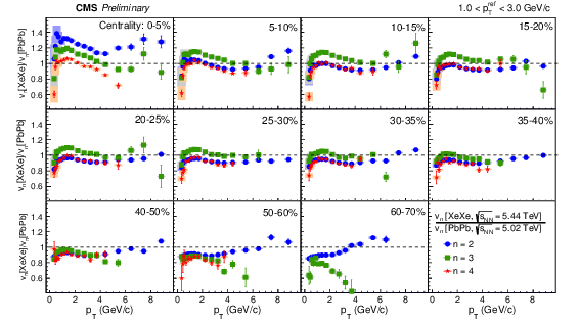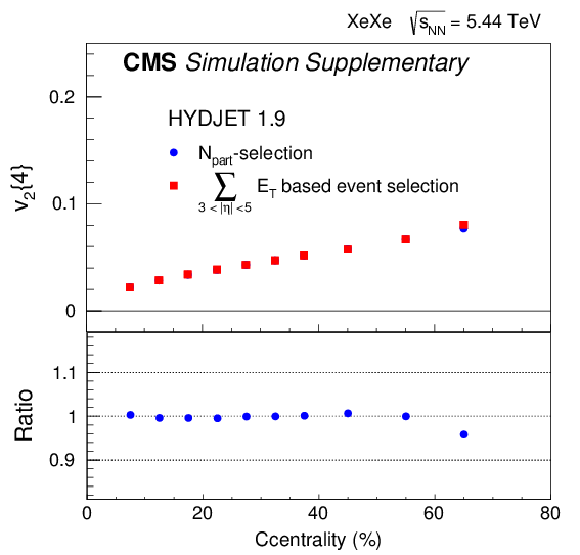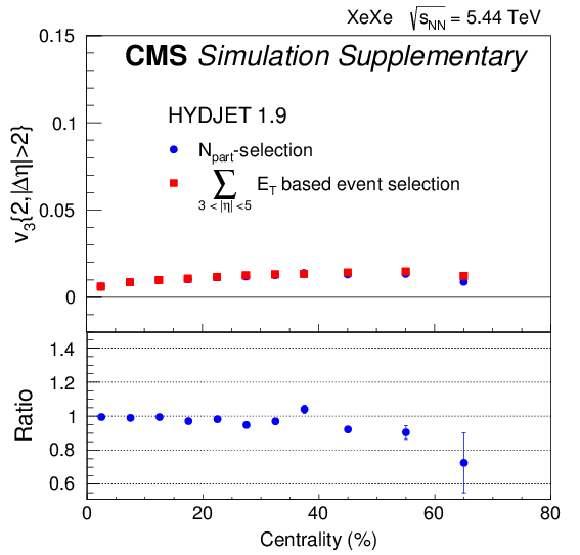

Compact Muon Solenoid
LHC, CERN
| CMS-PAS-HIN-18-001 | ||
| Charged particle angular correlations in XeXe collision at ${\sqrt {\smash [b]{s_{_{\mathrm {NN}}}}}} = $ 5.44 TeV | ||
| CMS Collaboration | ||
| May 2018 | ||
| Abstract: Azimuthal correlations of charged particles in xenon-xenon collisions at $ {\sqrt {\smash [b]{s_{_{\mathrm {NN}}}}}} =$ 5.44 TeV are studied using data collected by the CMS experiment at the CERN LHC. The $v_{2}$, $v_{3}$, and $v_{4}$ Fourier coefficients that characterize the azimuthal behavior are obtained using two-particle correlations, the scalar product method and the multiparticle cumulant method. Within a hydrodynamic picture, these methods have different sensitivities to non-flow and flow fluctuation effects. The system size dependence of the results is explored by taking ratios with comparable results found in PbPb collisions. Model calculations that include fluctuation effects are compared to the experimental results. | ||
|
Links:
CDS record (PDF) ;
CADI line (restricted) ;
These preliminary results are superseded in this paper, PRC 100 (2019) 044902. The superseded preliminary plots can be found here. |
||
| Figures | Summary | Additional Figures | References | CMS Publications |
|---|
| Figures | |

png pdf |
Figure 1:
Elliptic flow coefficient, $v_2$, based on different analysis techniques, as a function of transverse momentum and in eleven centrality bins. The results for the 2- and multi-particle correlations correspond to the range $|\eta | < $ 2.4, while the SP results are for $|\eta | < $ 0.8. The shaded boxes represent systematic uncertainties. |

png pdf |
Figure 2:
Triangular flow coefficients, $v_3$, based on the different analysis techniques, as a function of transverse momentum and in eleven centrality bins. The results for the 2- and multi-particle correlations correspond to the range $|\eta | < $ 2.4, while the SP results are for $|\eta | < $ 0.8. The shaded boxes represent systematic uncertainties. |

png pdf |
Figure 3:
The $v_4$ coefficients, based on the different analysis techniques, as a function of transverse momentum and in eleven centrality bins. The results for the 2- and multi-particle correlations correspond to the range $|\eta | < $ 2.4, while the SP results are for $|\eta | < $ 0.8. The shaded boxes represent systematic uncertainties. |

png pdf |
Figure 4:
Centrality dependence of the spectrum-weighted $v_2$, $v_3$ and $v_4$ flow harmonics with 0.3 $ < p_{\mathrm{T}} < $ 3.0 GeV/$c$. The $v_2$ results are shown for 2-, 4-, 6- and 8-particle correlations (left panel). The $v_3$ results are shown for 2- and 4-particle correlations (middle panel), while the $v_4$ values are presented for two-particle correlations technique, only. The shaded boxes represent systematic uncertainties. |

png pdf |
Figure 5:
Centrality dependence of $v_2\{4\}/v_2\{2\}$, $v_2\{6\}/v_2\{4\}$ (left panel) and $v_3\{4\}/v_3\{2\}$ (right panel) ratios. Theoretical predictions based on the IP-Glasma + Music + UrQMD and the hydrodynamic model from Ref. [31] are compared to the data. |

png pdf |
Figure 6:
Comparison of $v_2$ results measured with two-particle correlations from two different systems, XeXe collisions at $ {\sqrt {\smash [b]{s_{_{\mathrm {NN}}}}}} = $ 5.44 TeV and PbPb collisions at $ {\sqrt {\smash [b]{s_{_{\mathrm {NN}}}}}} = $ 5.02 TeV, shown as a function of $ p_{\mathrm{T}} $ in eleven centrality bins. The shaded boxes represent systematic uncertainties. |

png pdf |
Figure 7:
Comparison of $v_3$ results measured with two-particle correlations from two different systems, XeXe collisions at $ {\sqrt {\smash [b]{s_{_{\mathrm {NN}}}}}} = $ 5.44 TeV and PbPb collisions at $ {\sqrt {\smash [b]{s_{_{\mathrm {NN}}}}}} = $ 5.02 TeV shown as a function of $ p_{\mathrm{T}} $ in eleven centrality bins. The shaded boxes represent systematic uncertainties. |

png pdf |
Figure 8:
Comparison of $v_4$ results measured with two-particle correlations from two different systems, XeXe collisions at $ {\sqrt {\smash [b]{s_{_{\mathrm {NN}}}}}} = $ 5.44 TeV and PbPb collisions at $ {\sqrt {\smash [b]{s_{_{\mathrm {NN}}}}}} = $ 5.02 TeV, shown as a function of $ p_{\mathrm{T}} $ in eleven centrality bins. The shaded boxes represent systematic uncertainties. |

png pdf |
Figure 9:
Centrality dependence of the spectrum-weighted $v_2$, $v_3$, and $v_4$ harmonic coefficient from two-particle correlations method with 0.3 $ < p_{\mathrm{T}} < $ 3.0 GeV/$c$ for XeXe collisions at $ {\sqrt {\smash [b]{s_{_{\mathrm {NN}}}}}} = $ 5.44 TeV and PbPb collisions at $ {\sqrt {\smash [b]{s_{_{\mathrm {NN}}}}}} = $ 5.02 TeV. The lower panels show the ratio of the results for the two systems. Theoretical predictions from Ref. [31] are compared to the data. The shaded boxes represent systematic uncertainties. |

png pdf |
Figure 10:
Ratio of the $v_2$, $v_3$, and $v_4$ harmonic coefficients from two-particle correlations for XeXe and PbPb collisions as a function of $ p_{\mathrm{T}} $ in eleven centrality bins. The shaded boxes represent systematic uncertainties. |
| Summary |
| In this note, the $v_2,v_3$ and $v_4$ azimuthal flow harmonics are shown for XeXe collisions at ${\sqrt {\smash [b]{s_{_{\mathrm {NN}}}}}} = $ 5.44 based on data obtained using the CMS detector. Three different analysis techniques, including two-particle correlations, the scalar product method, and the multiparticle cumulant method, are used to explore the fluctuation behavior through the different effect of flow fluctuations on each of these techniques. The harmonic coefficients are compared to those found with PbPb collisions at ${\sqrt {\smash [b]{s_{_{\mathrm {NN}}}}}} = $ 5.02 TeV to explore the influence of the system size. The magnitude of the $v_2$ coefficients for XeXe collisions are larger than found in PbPb collisions for the most central collisions. This is attributed to a larger fluctuation component in the lighter collision system. In more peripheral events, PbPb $v_n$ coefficients are consistently greater than those found for XeXe collisions. This behavior is qualitatively consistent with expectations from hydrodynamic models. A clear ordering $v_2\{2\} > v_2\{4\} \approx v_2\{6\} \approx v_2\{8\}$ is observed, with a splitting of 2-3% for $v_2\{6\}/v_2\{4\}$. The $v_3\{4\} / v_3\{2\}$ ratio is found to be significantly smaller than the $v_2\{4\} / v_2\{2\}$ ratio for XeXe collisions, suggesting a dominant fluctuation component for the $v_3$ harmonic. Hydrodynamic models that consider the xenon nuclear deformation are better able to reproduce the centrality dependence of the $v_{2}[\mathrm{XeXe}]/v_{2}[\mathrm{PbPb}]$ ratio, although the deformation appears to have little effect on the overall fluctuation behavior. These measurements provide new tests on the hydrodynamics models and help to constrain hydrodynamical descriptions of the nuclear collisions. |
| Additional Figures | |

png pdf |
Additional Figure 1:
Upper panel: $v_2$ measured with two-particle correlations as a function of centrality in XeXe collisions from HYDJET generator at 5.44 TeV after selecting events based on the generator level $N_{\text{coll}}$ (circles), or using event selection based on total $E_{\mathrm{T}}$ measured in forward region (squares). Bottom panel: the ratio of the blue to the red points in the upper panel. |

png pdf |
Additional Figure 2:
Upper panel: $v_2$ measured with multi-particle cumulants as a function of centrality in XeXe collisions from HYDJET generator at 5.44 TeV after selecting events based on the generator level $N_{\text{coll}}$ (circles), or using event selection based on total $E_{\mathrm{T}}$ measured in forward region (squares). Bottom panel: the ratio of the blue to the red points in the upper panel. |

png pdf |
Additional Figure 3:
Upper panel: $v_3$ measured with two-particle correlations as a function of centrality in XeXe collisions from HYDJET generator at 5.44 TeV after selecting events based on the generator level $N_{\text{coll}}$ (circles), or using event selection based on total $E_{\mathrm{T}}$ measured in forward region (squares). Bottom panel: the ratio of the blue to the red points in the upper panel. |
| References | ||||
| 1 | F. Karsch | Lattice QCD at High Temperature and Density | Lect.Notes.Phys. 583 (2002) 209--249 | hep-lat/0106019 |
| 2 | BRAHAMS Collaboration | Quark Gluon Plasma an Color Glass Condensate at RHIC? The perspective from the BRAHMS experiment | NP A 757 (2005) 1 | nucl-ex/0410020 |
| 3 | PHOBOS Collaboration | The PHOBOS Perspective on Discoveries at RHIC | NP A 757 (2005) 28 | nucl-ex/0410022 |
| 4 | STAR Collaboration | Experimental and Theoretical Challenges in the Search for the Quark Gluon Plasma: The STAR Collaboration's Critical Assessment of the Evidence from RHIC Collisions | NP A 757 (2005) 102 | nucl-ex/0501009 |
| 5 | PHENIX Collaboration | Formation of dense partonic matter in relativistic nucleus-nucleus collisions at RHIC: Experimental evaluation by the PHENIX collaboration | NP A 757 (2005) 184 | nucl-ex/0410003 |
| 6 | CMS Collaboration | Evidence for collectivity in pp collisions at the LHC | PLB 765 (2017) 193 | CMS-HIN-16-010 1606.06198 |
| 7 | CMS Collaboration | Evidence for collective multi-particle correlations in pPb collisions | PRL 115 (2015) 012301 | CMS-HIN-14-006 1502.05382 |
| 8 | ATLAS Collaboration | Measurement of multi-particle azimuthal correlations with the subevent cumulant method in pp and p+pb collisions with the atlas detector at the lhc | PRC 97 (2018) 024904 | 1708.03559 |
| 9 | STAR Collaboration | Charged and strange hadron elliptic flow in Cu+Cu collisions at 62.4 and 200 GeV | PRC 98 (2010) 044902 | 1001.5052 |
| 10 | PHENIX Collaboration | Scaling properties of azimuthal anisotropy in Au+Au and Cu+Cu collisions at $ \sqrt{s_{NN}} = $ 200 ~GeV | PRL 98 (2007) 162301 | nucl-ex/0608033 |
| 11 | J.-Y. Ollitrault | Determination of the reaction plane in ultrarelativistic nuclear collisions | Phys.Rev. D 48 (1993) 1132 | hep-ph/9303247 |
| 12 | S. Voloshin and Y. Zhang | Flow study in relativistic nuclear collisions by Fourier expansion of azimuthal particle distributions | Z. Phys. C 70 (1994) 665--672 | hep-ph/9407282 |
| 13 | A. M. Poskanzer and S. A. Voloshin | Methods for analyzing anisotropic flow in relativistic nuclear collisions | PRC 58 (1998) 1671 | nucl-ex/9805001 |
| 14 | B. Alver and G. Roland | Collision geometry fluctuations and triangular flow in heavy-ion collisions | Phys.Rev. C81 (2010) 054905 | 1003.0194 |
| 15 | Y. Li and J.-Y. Ollitrault | $ v_4,v_5,v_6,v_7 $: nonlinear hydrodynamic response vs LHC data | Phys.Lett. B 744 (2015) 82--87 | 1502.02502 |
| 16 | J.-Y. Ollitrault, A. M. Poskanzer, and S. A. Voloshin | Effect of flow fluctuations and nonflow on elliptic flow methods | Phys.Rev. C 80 (2009) 014904 | 0904.2315 |
| 17 | CMS Collaboration | Description and performance of track and primary-vertex reconstruction with the CMS tracker | JINST 9 (2014) P10009 | CMS-TRK-11-001 1405.6569 |
| 18 | CMS Collaboration | The CMS experiment at the CERN LHC | JINST 3 (2008) S08004 | CMS-00-001 |
| 19 | GEANT4 Collaboration | Geant4 --- a simulation toolkit | NIMA 506 (2003) 250 | |
| 20 | M. L. Miller et al. | Glauber modeling in high energy nuclear collisions | Ann. Rev. Nucl. Part. Sci. 57 (2007) 205 | nucl-ex/0701025 |
| 21 | CMS Collaboration | Long-range and short-range dihadron angular correlations in central PbPb collisions at $ \sqrt{s_{NN}}= $ 2.76 TeV | JHEP 7 (2011) 076 | CMS-HIN-11-001 1105.2438 |
| 22 | CMS Collaboration | Centrality dependence of dihadron correlations and azimuthal anisotropy harmonics in PbPb collisions at $ \sqrt{s_{NN}}= $ 2.76 ~TeV | European Physics Journal C 72 (2012) 10052 | CMS-HIN-11-006 1201.3158 |
| 23 | CMS Collaboration | Pseudorapidity and transverse momentum dependence of flow harmonics in pPb and PbPb collisions | CMS-HIN-15-008 1710.07864 |
|
| 24 | CMS Collaboration | Measurement of mixed higher order flow harmonics in PbPb collisions | link | CMS-PAS-HIN-16-018 |
| 25 | A. Bilandzic, R. Snellings, and S. Voloshin | Flow analysis with cumulants: Direct calculations | Phys.Rev. C83 (2011) 044913 | 1010.0233 |
| 26 | CMS Collaboration | Evidence for Collective Multiparticle Correlations in p-Pb Collisions | PRL 115 (2015), no. 1, 012301 | CMS-HIN-14-006 1502.05382 |
| 27 | CMS Collaboration | Multiplicity and transverse momentum dependence of two- and four-particle correlations in pPb and PbPb collisions | PLB724 (2013) 213--240 | CMS-HIN-13-002 1305.0609 |
| 28 | A. Bilandzic et al. | Generic framework for anisotropic flow analyses with multiparticle azimuthal correlations | Phys.Rev. C89 (2014), no. 6, 064904 | 1312.3572 |
| 29 | B. Schenke and S. Schlichting | 3-D Glasma initial state for relativistic heavy ion collisions | Phys.Rev. C94 (2016) 044907 | 1605.07158 |
| 30 | H. Petersen et al. | Fully integrated transport approach to heavy ion reactions with an intermediate hydrodynamic stage | Phys.Rev. C78 (2008) 044901 | 0806.1695 |
| 31 | G. Giacalone, J. Noronha-Hostler, M. Luzum, and J.-Y. Ollitrault | Hydrodynamic predictions for 5.44 TeV Xe+Xe collisions | Unpublished (2017) | 1711.08499 |
| 32 | P. Moller, S. A. J., T. Ichikawa, and H. Sagawa | Nuclear ground-state masses and deformations: FRDM(2012) | 1508.06294 | |
| 33 | R. Bhalerao, M. Luzum, and J.-Y. Ollitrault | Understanding anisotropy generated by fluctuations in heavy-ion collisions | Phys.Rev. C84 (2011) 054901 | 1107.5485 |
| 34 | P. Romatschke and U. Romatschke | Viscosity Information from Relativistic Nuclear Collisions: How Perfect is the Fluid Observed at RHIC? | Phys.Rev. Lett. 99 (2007) 172301 | 0706.1522 |

|
Compact Muon Solenoid LHC, CERN |

|

|

|

|

|

|